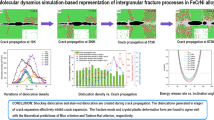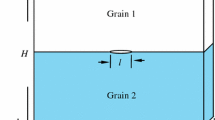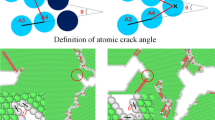Abstract
Structural failure of the polycrystalline material is influenced by the interaction between the crystal and their boundaries. Specifically, a ductile material such as copper exhibit the different mechanisms of failure depending on the direction of the crack propagation within the grain boundary. Such directional anisotropy is often studied based on Rice’s criteria, which has the analytic solution in the grain boundary with [110] rotation of the axis. In this work, we expand the study of such intergranular directionality to a propagation within [100] grain boundary. This work introduces the inherent bias found in the intergranular fracture of [100] grain boundaries, using molecular dynamics simulations. Later, such observation is shown to agree with the relative crack propagation velocities, and cohesive energies obtained at the crack tip vicinity. These anisotropic trends are lastly correlated with the detailed atomistic movements observed during structural failures. These findings are to be used in improving the simulation capability and predictability of crack propagation.
Similar content being viewed by others
References
D. E. Spearot, K. I. Jacob and D. L. McDowell, Nucleation of dislocations from [001]_bicrystal interfaces in aluminum, Acta Mater., 53 (2005) 3579–3589.
D. E. Spearot, K. I. Jacob and D. L. McDowell, Dislocation nucleation from bicrystal interfaces with dissociated structure, Int. J. Plast., 23 (2007) 143–160.
D. E. Spearot, L. Capolungo, J. Qu and M. Cherkaoui, On the elastic tensile deformation of <100> bicrystal interfaces in copper, Comput. Mater. Sci., 42 (2008) 57–67.
N. A. Fleck, J. W. Hutchinson and S. Zhigang, Crack path selection in a brittle adhesive layer, Int. J. Solids Struct., 27 (1991) 1683–170.
A. Luque, J. Aldazabal, J. M. Martínez–Esnaola and J. Gil Sevillano, Molecular dynamics simulation of crack tip blunting in opposing directions along a symmetrical tilt grain boundary of copper bicrystal, Fatigue Fract. Eng. Mater. Struct., 30 (2007) 1008–1015.
C. E. Carlton and P. J. Ferreira, What is behind the inverse Hall–Petch effect in nanocrystalline materials?, Acta Mater., 55 (2007) 3749–3756.
J.–S. Wang and P. M. Anderson, Fracture behavior of embrittled F.C.C. metal bicrystals, Acta Metall. Mater., 39 (1991) 779–792.
J. D. Rittner and D. N. Seidman, <110> Symmetric tilt grain–boundary structures in Fcc metals with low stackingfault energies, Phys. Rev. B, 54 (1996) 6999–7015.
Y. Cheng, Z. H. Jin, Y. W. Zhang and H. Gao, On intrinsic brittleness and ductility of intergranular fracture along symmetrical tilt grain boundaries in copper, Acta Mater., 58 (2010) 2293–2299.
Y. Cheng, M. X. Shi and Y. W. Zhang, Atomistic simulation study on key factors dominating dislocation nucleation from a crack tip in two FCC materials: Cu and Al, Int. J. Solids Struct., 49 (2012) 3345–3354.
M. A. Tschopp and D. L. Mcdowell, Asymmetric tilt grain boundary structure and energy in copper and aluminium, Philos. Mag., 87 (2007) 3871–3892.
T. Shimada, K. Ouchi, Y. Chihara and T. Kitamura, Breakdown of continuum fracture mechanics at the nanoscale, Sci. Rep., 5 (2015) 8596.
I. Adlakha, M. A. Tschopp and K. N. Solanki, The role of grain boundary structure and crystal orientation on crack growth asymmetry in aluminum, Mater. Sci. Eng. A, 618 (2014) 345–354.
I. Adlakha, K. N. Solanki and M. A. Tschopp, Influence of grain boundary structure on interfacial fracture under tensile loading: Cohesive zone model informed by atomistic simulations, TMS2013 Supplemental Proceedings (2013) 753–758.
R. Abadi, R. Palanivel, M. Izadifar and T. Rabczuk, The effect of temperature and topological defects on fracture strength of grain boundaries in single–layer polycrystalline boron–nitride nanosheet, Comput. Mater. Sci., 123 (2016) 277–286.
P. R. Budarapu, R. Gracie, S. Yang, X. Zhuang and T. Rabczuk, Efficient coarse graining in multiscale modeling of fracture, Theor. Appl. Fract. Mech., 69 (2014) 126–143.
P. R. Budarapu, R. Gracie, S. P. A. Bordas and T. Rabczuk, An adaptive multiscale method for quasi–static crack growth, Compt. Mech., 53 (2014) 1129–1148.
H. Talebi, M. Silani, S. P. A. Bordas, P. Kerfriden and T. Rabczuk, A computational library for multiscale modeling of material failure, Comput. Mech., 53 (2014) 1047–1071.
H. Talebi, M. Silani and T. Rabczuk, Concurrent multiscale modeling of three dimensional crack and dislocation propagation, Adv. Eng. Softw., 80 (2015) 82–92.
Y. Mishin, M. J. Mehl, D. A. Papaconstantopoulos, A. F. Voter and J. D. Kress, Structural stability and lattice defects in copper: Ab initio, tight–binding, and embedded–atom calculations, Phys. Rev. B, 63 (2001) 224106.
D. Brandon, The structure of high–angle grain boundaries, Acta Metall., 14 (1966) 1479–1484.
A. P. Sutton and V. Vitek, On the structure of tilt grain boundaries in cubic metals II. Asymmetrical tilt boundaries, Philos. Trans. R. Soc. A Math. Phys. Eng. Sci., 309 (1983) 37–54.
A. P. Sutton and R. W. Balluffi, Interfaces in crystalline materials, Oxford: Oxford Scientific Publications (1995).
D. Spearot, K. Jacob and D. McDowell, Molecular dynamics simulations of grain boundary decohesion in FCC copper and aluminum, 45th AIAA/ASME/ASCE/AHS/ASC Struct. Struct. Dyn. & Mater. Conf. (2004) 1–11.
T. Kitamura, K. Yashiro and R. Ohtani, Atomic simulation on deformation and fracture of nano–single crystal of nickel in tension, JSME Int. J. Ser. A, 40 (1997) 430–435.
A. Stukowski, Visualization and analysis of atomistic simulation data with OVITO–the open visualization tool, Model. Simul. Mater. Sci. Eng., 18 (2010) 15012.
D. Farkas, Fracture mechanisms of symmetrical tilt grain boundaries, Philos. Mag. Lett., 80 (2000) 229–237.
H. Krull and H. Yuan, Suggestions to the cohesive tractionseparation law from atomistic simulations, Eng. Fract. Mech., 78 (2011) 525–533.
K. Y. Volokh, Comparison between cohesive zone models, Commun. Numer. Methods Eng., 20 (2004) 845–856.
S. Plimpton, Fast parallel algorithms for short–range molecular dynamics, J. Comput. Phys., 117 (1995) 1–19.
K. B. Broberg, How fast can a crack go?, Mater. Sci., 32 (1996) 80–86.
F. F. Abraham, The atomic dynamics of fracture, J. Mech. Phys. Solids., 49 (2001) 2095–2111.
Y. Zhou, Z. Yang and Z. Lu, Dynamic crack propagation in copper bicrystals grain boundary by atomistic simulation, Mater. Sci. Eng. A, 599 (2014) 116–124.
K. Park and G. H. Paulino, Computational implementation of the PPR potential–based cohesive model in ABAQUS: Educational perspective, Eng. Fract. Mech., 93 (2012) 239–262.
A. Latapie and D. Farkas, Molecular dynamics investigation of the fracture behavior of nanocrystalline α–Fe, Phys. Rev. B, 69 (2004) 134110.
D. Farkas, B. Hyde, R. Nogueira and M. Ruda, Atomistic simulations of the effects of segregated elements on grainboundary fracture in body–centered–cubic Fe, Metall. Mater. Trans. A, 36 (2005) 2067–2072.
Author information
Authors and Affiliations
Corresponding author
Additional information
Recommended by Associate Editor Seunghwa Yang
Hayoung Chung received his Ph.D. from Division of Multiscale and Mechanical Design in Mechanical and Aerospace Engineering at Seoul National University in 2017. Currently, he is a postdoctoral researcher at UC San Diego. His research interest includes multiscale mechanics and related numerical methods. Now he is pursuing multiscale topology optimization.
Rights and permissions
About this article
Cite this article
Chung, H., Cho, M. A molecular dynamics study on the biased propagation of intergranular fracture found in copper STGB. J Mech Sci Technol 32, 5351–5361 (2018). https://doi.org/10.1007/s12206-018-1034-7
Received:
Revised:
Accepted:
Published:
Issue Date:
DOI: https://doi.org/10.1007/s12206-018-1034-7




